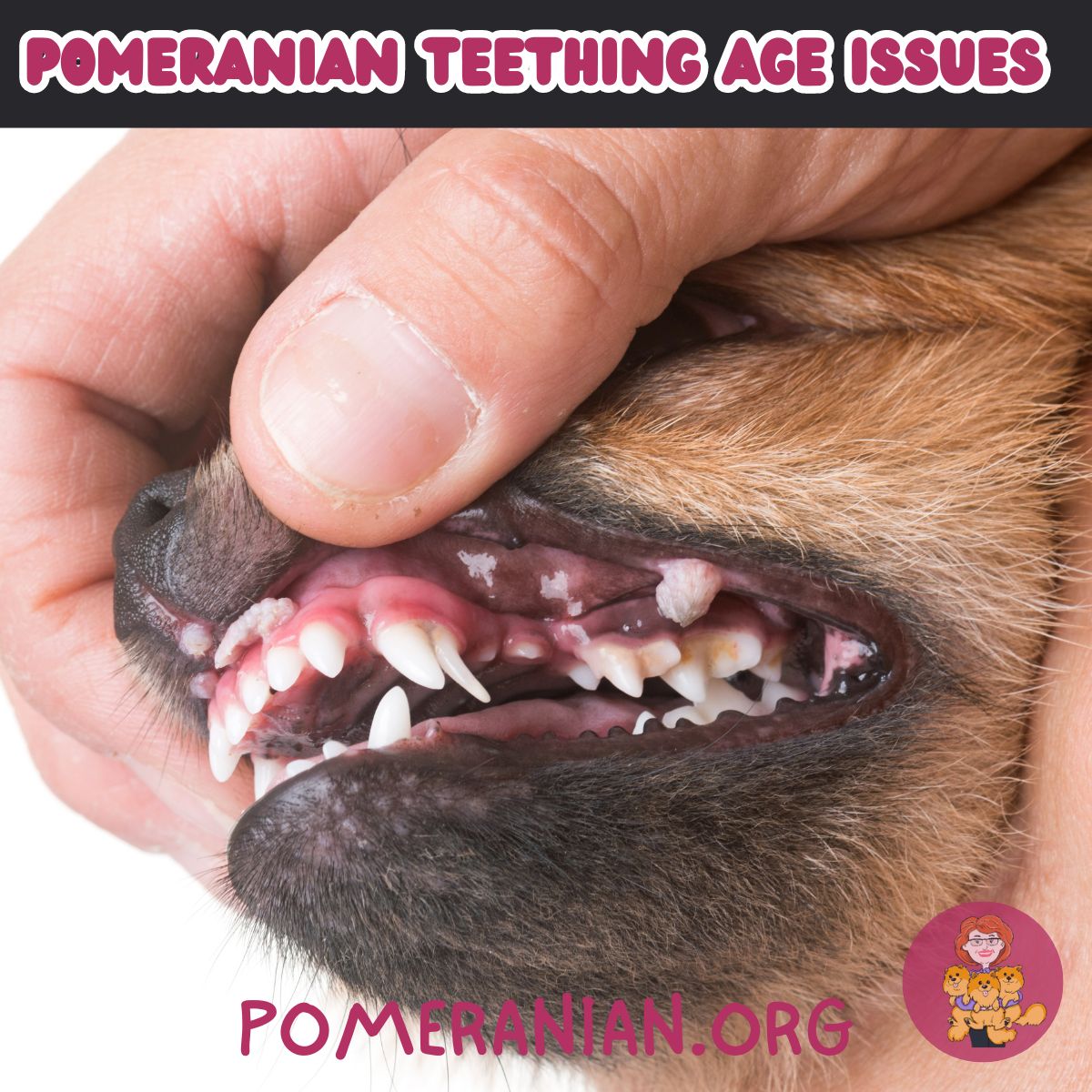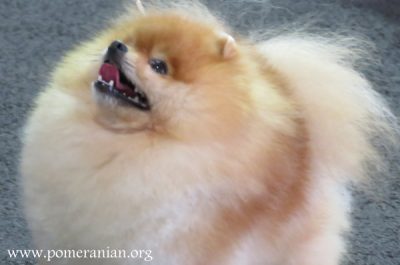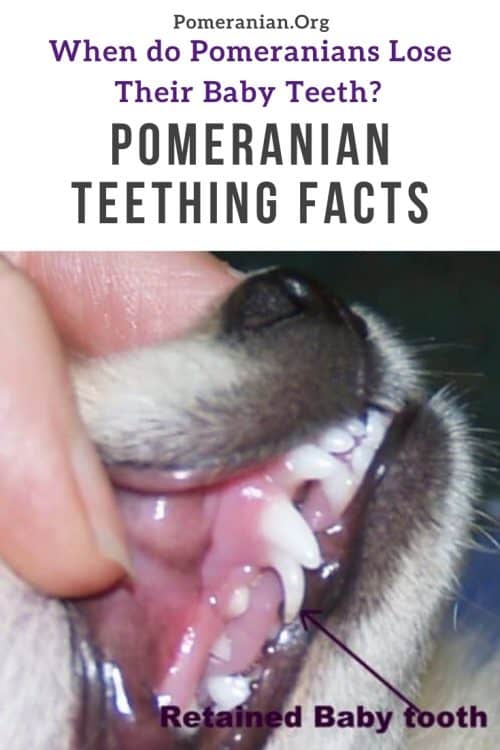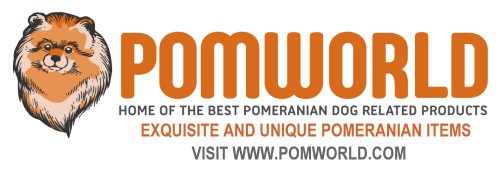Last Updated on 25/04/2024 by Denise Leo. Post first published on January 5, 2016.
Bringing a Pomeranian puppy into your home marks the beginning of a delightful adventure, brimming with cute experiences and a few challenges, one of which is teething. As your fluffy companion grows, they will experience teething, a natural but sometimes troublesome process.
In this blog post, we’ll explore everything you need to know about Pomeranian teething, from understanding the stages to providing relief and proper care. Whether you’re a new or seasoned Pomeranian owner, this guide will assist you in confidently navigating the teething phase, ensuring your pup grows healthy and happy.
Pomeranian Teething Age Explained
When Pomeranian puppies are born, they have no teeth. The first teeth grow when they’re 6 – 8 weeks old, called deciduous teeth (more commonly known as puppy teeth).
A Pomeranian losing teeth will have the incisors come out first, then the premolars and canine teeth. Pomeranians have premolars but not molars. The canine teeth are much bigger, and the top and bottom canines are at the back of the mouth. Both bottom and top incisors are found in the middle section of the Pom’s mouth.
The Pomeranian puppy’s second teething phase commences at about four months old. Don’t be concerned if you notice Pomeranian teeth falling out. The teeth roots are absorbed, and the new adult teeth should quickly push the Pomeranian’s puppy teeth out of the gum.
However, there are times when this doesn’t occur, and retained baby teeth are a common Pomeranian problem. The incisors start falling out around the age of four months so that new adult teeth can grow into those spaces.
At five months of age, the adult canines and molars will start growing, and by the end of the eighth month, your Pomeranian should have all his new teeth. This process is often slower for smaller puppies.
Occasionally, these permanent teeth don’t push out the deciduous teeth. If your puppy has both teeth simultaneously, it’s known as retained deciduous teeth. This will generally happen in a Pomeranian, where the upper and lower canine baby teeth are retained.
The Pomeranian puppy teething process usually drags on for a few months, but it’s not always painful daily. However, it can be painful and very uncomfortable for your Pom.
During this period, puppies chew and bite more, trying different textures and objects to help ease their discomfort.

When do Pomeranians Lose Their Baby Teeth?
Pomeranian Puppy Teething Timeline:
- 4 to 6 weeks, Pomeranian puppy teeth start appearing in the gums and should be complete by the 8-week mark.
- At four months old, the Pomeranian puppy starts losing puppy incisor teeth, and the adult incisors grow in.
- A 5-month-old Pomeranian puppy will experience the adult canine teeth growing in, and the puppy canine teeth should fall out.
- A 6-month-old Pomeranian should have molars growing in.
- An 8-month-old Pomeranian puppy should have a complete set of adult teeth and have lost all puppy teeth.
When Do Pomeranians Stop Teething?
A Pomeranian puppy should have all 42 teeth by the end of the eighth month. Poms frequently have problems associated with teething. Sometimes, the deciduous teeth aren’t pushed out by the adult teeth. If this happens, these teeth are called retained deciduous teeth.
The most common teeth to remain are the Pom’s canine teeth. Your vet needs to check your Pomeranian when he’s three or four months old to ensure he won’t have problems with his bite. If this is the case, removing the baby’s teeth prematurely will need to happen.
Pomeranian Teething Issues
Pomeranian puppy teeth issues are common. Does your Pomeranian have two sets of teeth, puppy and adult? Some young Pomeranians may have their adult teeth erupt while their puppy teeth are still in the gum, an issue referred to as Pomeranian double teeth.
This is known as Pomeranian Retained Deciduous (Puppy) Teeth. Sometimes, only the puppy’s canine teeth are retained. A Pom puppy with retained Pomeranian puppy teeth has health risks.
What are the Symptoms and Signs of Pomeranian Retained Puppy Teeth?

If a Pomeranian puppy has retained his baby teeth, a permanent tooth appears next to the baby tooth it should have pushed out. The permanent tooth can appear beside or in front of the baby tooth.
It’s common for toy dog puppies to have retained baby teeth, and a Pomeranian puppy should have his teeth checked by a vet during the teething stage to avoid later mouth and chewing problems.
Pomeranian Double Teeth
If you look in your Pomeranian’s mouth, do you see double the number of teeth growing? If the answer is yes, there’s nothing wrong with your eyes. Your Pom can have more teeth than normal.
If this is the case, taking your Pomeranian to the local vet is the wisest action. If the extra teeth aren’t removed, they’ll rub on each other and can cause his enamel to be destroyed. Treating extra fangs this way will restore enamel, decrease tartar and plaque build-up, and ease pain and discomfort.
What is the Meaning of Pomeranian Double Teeth?
It’s common for a Pomeranian to have teething problems. He may have two sets of teeth, baby teeth that refuse to come out, or missing teeth completely. “Double teeth” is the slang term for two sets of teeth.
If you don’t realize your Pet has this issue early enough, he may endure certain health problems. This is why you should regularly check his mouth and teeth.
What’s the Best Way to Recognize Double Teeth in My Dog?
The first step is to look in your dog’s mouth properly. You should look to see if there are any gaps, missing teeth, or double teeth and then look at the jaw. Look for abnormalities in the position of the teeth or in the total number of teeth in his mouth.
If I See Double Teeth in My Dog’s Mouth, Is That Cause for Concern?
If your Pomeranian has double teeth, his looks are not the only problem. Other problems may include inflammation, discomfort, pain, pulp infection, and a dead tooth.
Pomeranian Retained Puppy Teeth Risks
- The mouth gets crowded if your pet has a baby and permanent teeth. This can even displace permanent teeth, so they grow at a bad angle. This abnormality may cause the jaw not to grow normally.
- The baby’s teeth may rub against the roof of the pet’s mouth, causing pain and injury. As a result, infections or abscesses can occur.
- A dog with two sets of teeth faces a higher risk of general and periodontal infections, possibly causing inflammation and/or pain. If your dog has double teeth, he’ll need a trip to the vet to discover the exact nature of the problem and if your dog needs to be treated. Better safe than sorry.
Pomeranian Teething Pain Relief
Let your puppy chew as much as possible if your puppy is teething. However, it would be best if you chose the right things for him to chew. You can buy teething toys.
Textured surfaces of the right size will let your puppy scratch the extremely itchy gums. Ice cubes are very useful. The puppy can lick them and then chew them to allow the coldness to ease the gums as they get into every crack. Add flavor to the ice cubes to taste good and reduce discomfort; your puppy will love you even more. Flavor can be added to the ice cubes by freezing low-salt chicken stock.
Final Thoughts on Pomeranian Teething Age Issues
When your Pomeranian puppy grows, teething is an important phase requiring attention and care. As these little fluffs transition from baby to adult teeth, you might notice them chewing more than usual. This is a natural part of their development, but it can sometimes lead to dental issues that must be addressed.
Examine your puppy’s mouth weekly until they are about nine months old to look for any signs of retained or irregular teeth. Early detection and proper management can ensure your Pomeranian’s oral health is on the right track, making this teething period as comfortable as possible for your furry friend.
Talk to your vet if you suspect there are retained Pomeranian baby teeth. Removing the retained puppy teeth and de-sexing your puppy are procedures that can be done simultaneously. Always consult a qualified Veterinary Surgeon if you are worried about your Pomeranian’s health.
Copyright Pomeranian.org. All Rights Reserved.
References and Further Reading:
[1] Denise Leo “The Pomeranian Handbook”.

Safe Puppy Teething Bones and Toys
- RELIEVES TEETHING DISCOMFORT – Made of Nylabone’s softest material, this puppy teething chew toy is designed for puppies without any adult teeth
- FREEZE TO SOOTHE GUMS – Place this puppy chew toy in the freezer to provide even more teething relief
- ENTERTAINING RING BONE SHAPE – Textured chew toy keeps pups happy and encourages healthy chewing habits
- PROMOTES DOG DENTAL HEALTH – Ridges and nubs massage gums and help reduce plaque and tartar buildup as puppies chew
- MADE IN THE USA – Puppy bone toy is proudly made in the United States
- SOFTER PUPPY CHEW TOY – Designed for puppies without adult teeth, the chicken flavored bone gently soothes gums during teething
- DURABLE CHEW TOY – Long-lasting bacon bone ideal for powerful puppies or pups with adult teeth
- HEALTHY DOG TREAT – Made with no added salt, no artificial preservatives, and no artificial colors
- SUPPORTS DOG ORAL HEALTH – Chew toys help reduce plaque and tartar as puppies chew
- USA MADE – Dog chews are proudly crafted in the United States
- Satisfy your dog’s natural urge to chew while promoting the dental benefits of clean teeth and general oral health
- Includes an extra small version of our signature Tuff Bone for tiny dogs under 10 pounds
- Constructed from durable, nylon and polyurethane with a multi-textured surface to withstand mild to moderate chewing
- Features a tempting bacon scent to peak your dog’s interest and deliver chewing satisfaction
- Colors vary. Product chosen at random during time of shipment
- Bam-bones PLUS products are designed for moderate and aggressive chewers. Made with natural, sustainable and renewable bamboo fiber and nylon, these are great as puppy chew sticks.
- Introducing these chew toys for dogs not only addresses your dog’s natural urge to chew but also aids in minimizing bacteria buildup and combating bad breath, serving as a dog teeth cleaning toy.
- Older dogs may need dog sticks to keep their jaws strong and teeth clean. Chewing is also a healthy way to relieve boredom and anxiety, reduce destructive behavior and provide mental stimulation.
- Engage your pup with dogwood chew stick toy for mental stimulation. Bam-bones PLUS toys are great puppy calming products.
- Ethical Products, Inc. was established in 1952. Our staff designs, sources and develops products from around the world and focuses on sustainable, Earth friendly products that are safe for your pets.
- 2 DOG CHEW TOYS – Made from flexible material for moderate chewing styles
- OCCUPIES AND ENTERTAINS – Tiny dog bones offer big chewing fun!
- HELPS CLEAN TEETH – Ridges and nubs help reduce plaque and tartar as dogs chew
- DELICIOUS FLAVORS THROUGHOUT – Chew toys feature allergen-free peanut butter flavor and savory bacon flavor
- FOR XX-SMALL DOGS – Size Tiny dog toys are intended for dogs up to 8 pounds
- Soak and freeze the whole bone and cloth of this interactive dog toy for a cool texture with added teething relief
- Soft dog toy made with material designed just for teething puppies
- Textured dog bone features soft bristles to help soothe gums
- Puppy chew toy includes wells that can be filled and frozen
- Chew toy for puppies up to 25 pounds
- Made In The USA
- Helps Relieve Teething Pain And Soreness
- Edible And Digestible
- Added Calcium For Healthy Teeth And Bones
- Fortified With Dhas Omega 3 Fatty Acids
- Rubber material for added strength
- Fun squeaker signals playtime
- Multiple textures add interest for dog
- Great shape to toss, carry and chase
- Age range description: All Life Stages
- Variety pack includes a total of 3 bags: 1 Chicken & 1 Pumpkin & 1 Peanut Butter, come try out all the good flavors!
- Ring-shaped treats are designed specifically to help relieve sore gums and teething pain with gentle massaging action.
- Features a palatable texture to massage gums without damaging immature teeth.
- Helps curb destructive chewing by providing your paw-tner with a beneficial outlet.
- Proudly made in the USA and completely edible and digestible for puppies of any breed.
- Made In The Usa
- Helps Relieve Teething Pain And Soreness
- Edible And Digestible
- Added Calcium For Healthy Teeth And Bones
- Fortified With Dhas Omega 3 Fatty Acids


















